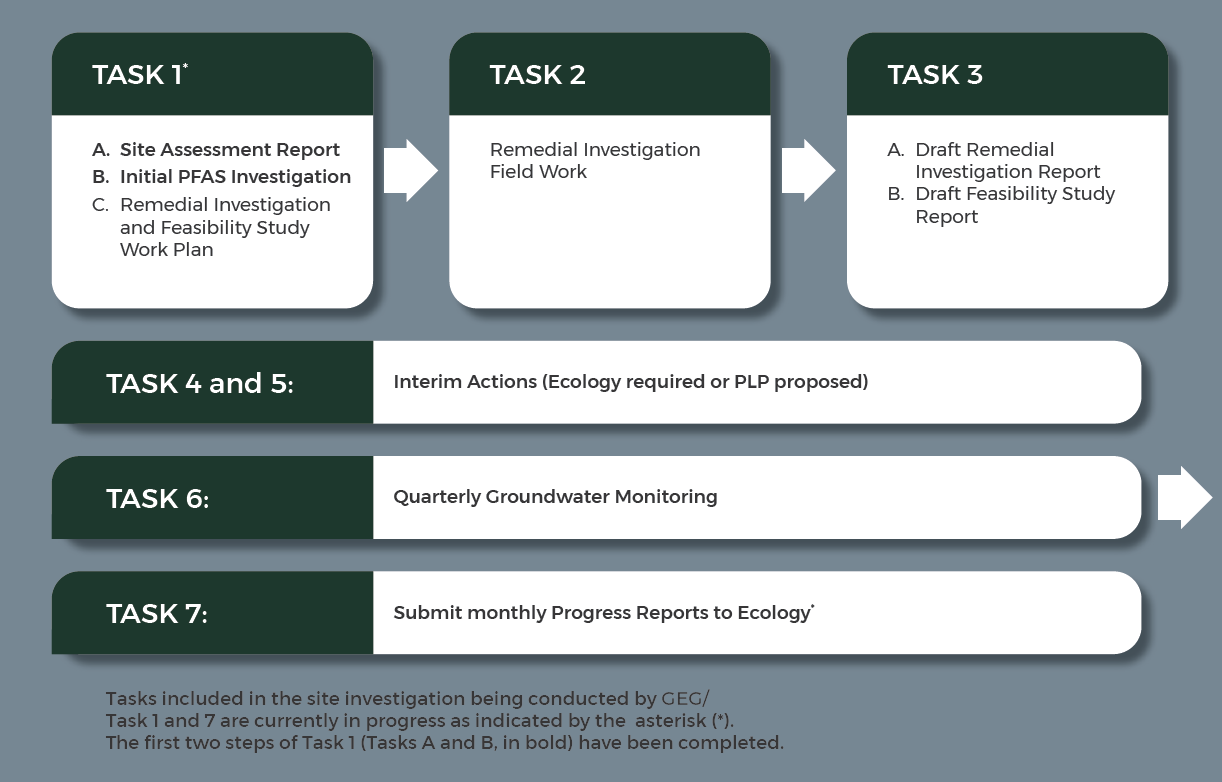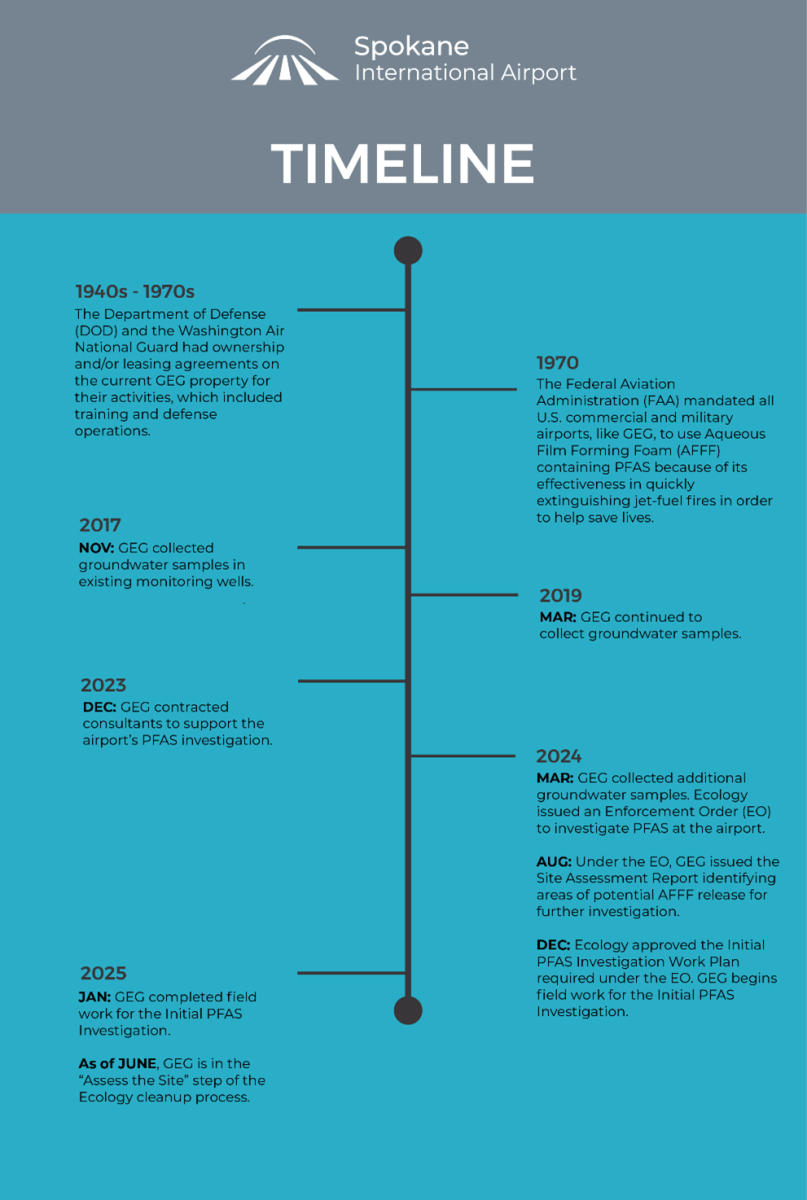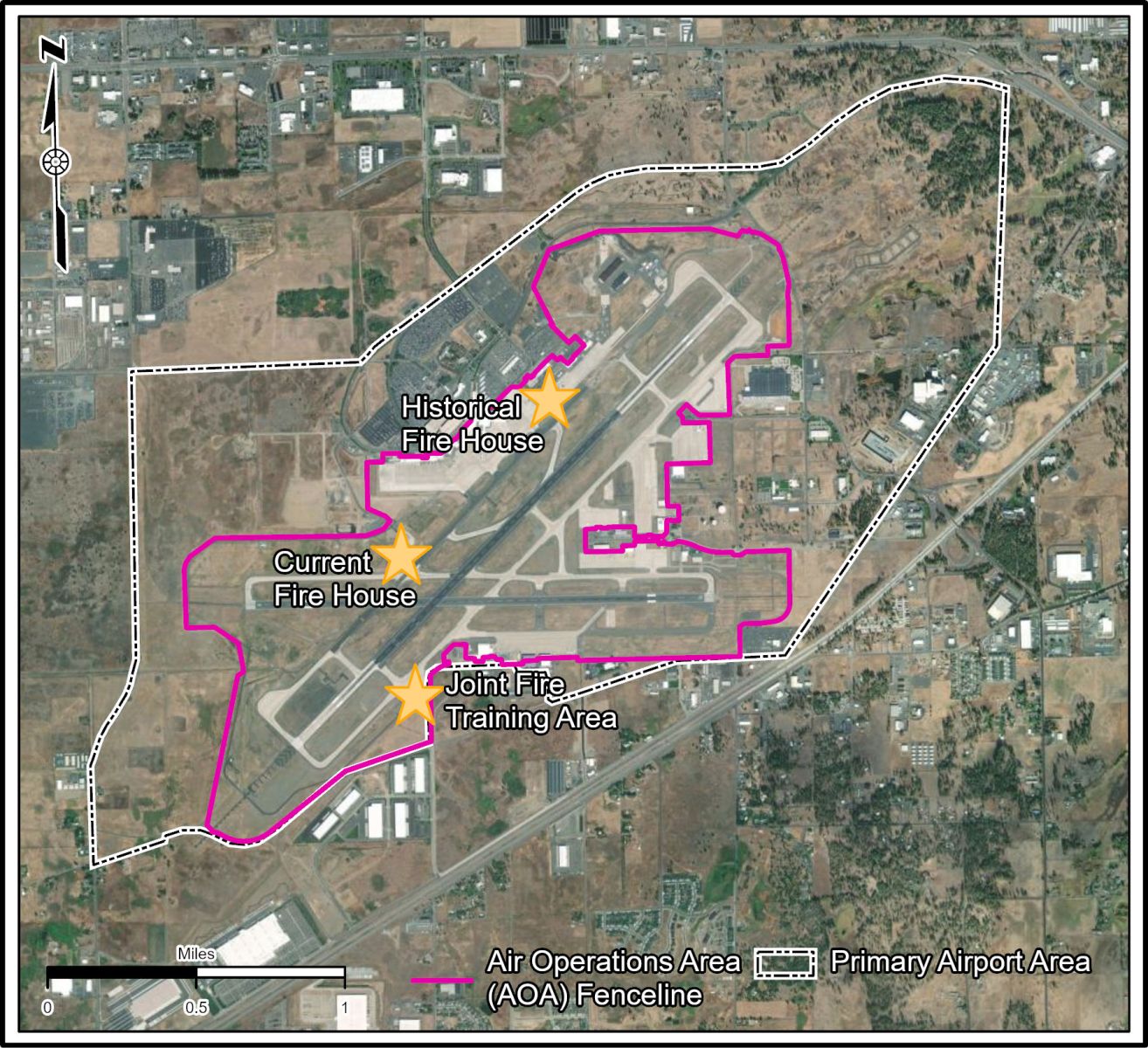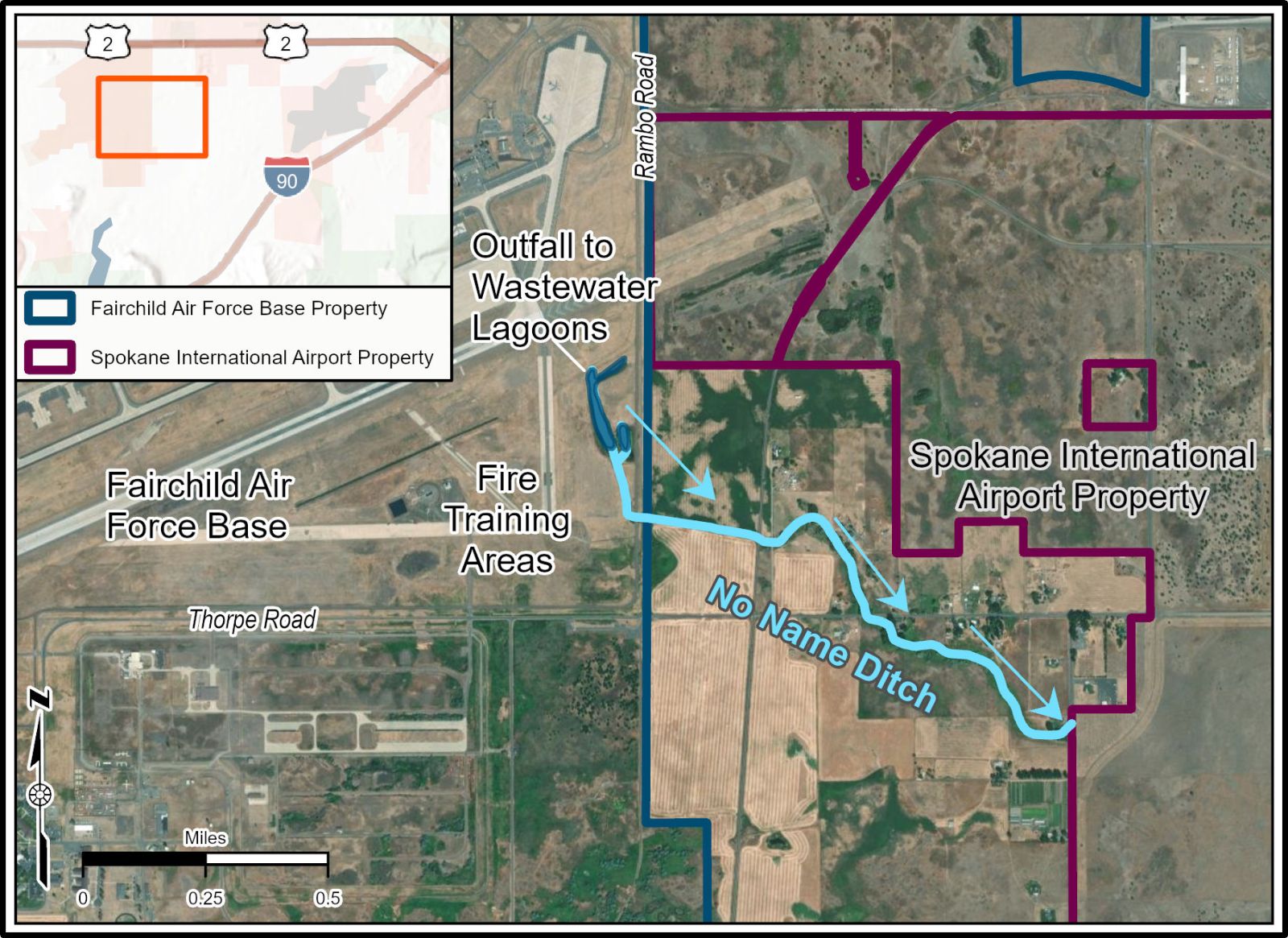June 2024
As a transportation hub for the Inland Northwest and a leading driver of economic growth, Spokane International Airport takes pride in its leadership role across all elements of our operations, with the safety of passengers, staff, and the Spokane/Coeur d’Alene regional communities we serve of paramount importance. This includes a commitment to the environment.
Because of this focus, in 2017 we initiated a voluntary assessment to determine the possible presence of a group of chemicals known as PFAS (Per- and Polyfluoroalkyl substances) in the groundwater on Airport property. This began after it was discovered that nearby Fairchild Air Force Base had contributed to elevated levels of PFAS in the drinking water intake wells in the City of Airway Heights. The information from this effort was gathered in order to be used for future decision-making following the disclosure of groundwater contamination caused by military activities near Airport property. In 2017, there were no federal or state regulatory requirements regarding PFAS and little was known of the many contributors of PFAS to the environment.
PFAS and the Federal Aviation Administration
The Federal Aviation Administration (FAA) long mandated that all U.S. commercial and military airports, including our Airport, use Aqueous Film Forming Foam (AFFF) because of its effectiveness in quickly extinguishing jet-fuel fires in order to help save lives. In addition, Washington State law mandated the Airport to operate subject to federal laws, rules, and regulations.
Expert knowledge in the risks associated with PFAS chemicals is relatively new and rapidly evolving, as depicted by a 2023 article in Time Magazine, with federal and state regulatory agencies having only very recently begun to assess their full scope and impact. It’s now understood that the presence and persistence of these man-made chemicals are also now known to be found in many everyday materials such as furniture, mattresses, non-stick cookware, dental floss, and more, including AFFF. Specifically, we now know that the federally mandated firefighting foam used since the 1970s has had PFAS in it. The Airport, like other commercial airports, did not know until recently about the potential for contamination from the use of the FAA-mandated AFFF.
Historic Airport Property Use: Geiger Field/GEG
It is important to note that the Airport was originally owned by the federal government as a Department of Defense (DOD) Airport during WWII, then known as Geiger Field, from which the three-letter identifier and GEG was derived.
During this period, several locations at the Airport were used as a military training site for firefighting operations, including the establishment and use of military burn pit sites.
Due to the type of training and contamination that occurred, and as a result of such operations, the DOD identified GEG as a Formerly Used Defense Site (FUDS) when the ownership was transferred to the local municipality. Under the FUDS Program, the DOD is responsible for cleaning up DOD-generated contamination on FUDS properties, which includes hazardous and toxic waste. From 1984 through 2003, the DOD tested, reported, and mitigated contamination of petroleum hydrocarbons above regulatory levels. During that era, PFAS was an unknown product, and as such was not identified as a hazardous or toxic material by the industry. In June 2006, the 242nd Combat Communications Squadron, Spokane Air National Guard Station, Washington Air National Guard, Spokane, Washington issued their Environmental Restoration Program Final Remedial Action Report and Environmental Covenant for their Geiger Field facilities located immediately adjacent to and on the South side of Spokane International Airport. The report details the groundwater contaminants and the remedial actions taken by the Guard’s contractor. In addition, the appraisal prepared by the Department of Natural Resources also highlights the concern for site contamination.
An Evolving National & Statewide Conversation
The United States EPA recognizes that airports are not responsible for the contamination on their property caused by a product they were required to use. The EPA’s Office of Enforcement and Compliance Assurance stated in an August 2023 memorandum: “OECA does not intend to pursue entities where equitable factors do not support CERCLA responsibility, such as farmers, water utilities, airports, or local fire departments, much as OECA exercises CERCLA enforcement discretion in other areas.” This policy was further clarified in an April 19, 2024, press release from the Biden-Harris administration that it was not the EPA’s intent “to pursue certain parties such as farmers, municipal landfills, water utilities, municipal airports, and local fire departments, where equitable factors do not support seeking CERLA cleanup or costs.”
Further, the State of Washington recognizes that the manufacturers and distributors of PFAS chemicals are the parties responsible for the contamination on the West Plains and throughout Washington and the country.
On May 30, 2023, the State of Washington commenced a lawsuit in King County Superior Court against twenty (20) manufacturers of PFAS containing products alleging that these companies have known about dangers of PFAS chemicals for decades and hid that knowledge from governments and the public while continuing to make substantial profits on those products.
We have been working with the Washington Department of Ecology since November 2023 on how we are proceeding with addressing PFAS concerns on the airport property, as well as future actions we are planning. We are committed to a reasonable, balanced approach that is necessary to ensure that a scientific and data-driven process is utilized while the Airport maintains its current and future obligations to the region. On March 29, 2024, Ecology issued an Order to establish the process by which PFAS will be further investigated on the airport. However, the airport had commenced its investigation prior to the Order’s issuance.
July 2025
GEG Advances Next Steps in Collaboration with Ecology
Spokane International Airport has completed Tasks 1A and 1B of the Washington State Department of Ecology (Ecology) Order Scope of Work (SOW) to investigate per- and polyfluoroalkyl substances (PFAS) that may be present at the airport. We are currently working through Task 2, Remedial Investigation. These steps are part of a comprehensive investigation to be taken in a scientific, data-driven process.
The SOW is divided into seven major tasks:

Task 1A included a Site Assessment Report that identified potential sources and historical activities that may have introduced PFAS to the environment. The report was completed in August 2024.
Task 1B was the Initial PFAS Investigation that included drafting a Work Plan to guide field activities and completing the proposed field activities. We completed the field activities in January 2025. We are currently reviewing results from the Initial PFAS Investigation and will issue a report summarizing our findings.
Task 2 includes a remedial investigation with the goal of delineating the nature and extent of PFAS contamination greater than applicable cleanup levels.
As of July 2025, GEG is in the “Assess the site” step of the Ecology cleanup process.

Below is a more detailed timeline of activities at the airport and the Ecology cleanup process:

What we have learned?
Under the EO, we are currently investigating potential source locations where PFAS may have been introduced in the environment. After the locations are investigation and it is confirmed PFAS has been released into the environment, the next step is to determine if there are environmental pathways that could transport PFAS present in soil and/or groundwater at the airport to areas that pose a possible risk to humans.
GEG’s Site Assessment Report to Ecology reviewed the airport’s history and use of AFFF. The report identified 10 potential source areas where AFFF may have been released within the airport's main operational area. We then further investigated potential source areas during the Initial PFAS Investigation. Preliminary results from the Initial PFAS Investigation further identify three of the 10 areas containing elevated PFAS concentrations in soil. These three areas include the current firehouse, historical firehouse, and burn pit. These, and any other identified areas, will be the focus of further investigations (see figure below). Final results from the Initial PFAS Investigation will be provided to Ecology when available.

We also identified potential sources of PFAS in the neighboring areas surrounding the airport, including the expanded focus area for the Fairchild Air Force Base PFAS investigation, which has been extended both northward and eastward. Our investigation identified that Fairchild Air Force Base uses a drainage pathway (known as No Name Ditch) from the stormwater pond that we understand drained AFFF impacted areas at Fairchild Air Force Base, leading directly onto GEG property. (See figure below of No Name Ditch).

How are we investigating for PFAS?
Under the Enforcement Order (EO), GEG was required to conduct an Initial PFAS Investigation. GEG’s Initial PFAS Investigation Work Plan explains where and how we investigated soil and groundwater on our property for PFAS. This initial study is important as soil and additional groundwater data is needed to understand the potential for PFAS to move through the environment. In addition, this study also provides the first measurements of PFAS in the soil at the potential or known source areas.
The Initial PFAS Investigation provides the first coordinated study of PFAS at GEG with groundwater samples collected from 50 monitoring wells and soil samples collected from 57 locations. GEG is currently reviewing results and will provided Ecology with final, validated, results when available. The findings from this study will serve as the basis for developing the work plan for the Remedial Investigation.
What's next?
In the coming years, we will continue to investigate PFAS in groundwater and soil on GEG’s property. Ongoing testing for PFAS in groundwater and soil will provide the necessary information to understand PFAS sources and movement in groundwater.
Under the EO, the airport will complete an Initial PFAS Investigation report later this year. The airport will provide Ecology a draft report for review. After the Initial PFAS Investigation report is finalized, the EO requires the airport to draft a Remedial Investigation and Feasibility Study Work Plan. After the Work Plan is approved by Ecology, the airport will complete the Remedial Investigation and Feasibility Study, conduct groundwater monitoring, and implement interim actions if necessary. In addition, the airport will continue to provide Ecology with monthly updates regarding process.
The information we are gathering related to regional and site-specific geology and hydrogeology will contribute to the ongoing investigations by the City of Spokane and Fairchild Air Force Base and our collective understanding of the PFAS origins and how it is moving.
We look forward to collaborating with the other investigations by the technical teams from Ecology, EPA, Eastern Washington University, and Fairchild Air Force Base to better understand the multiple sources of PFAS in our local area and how they are moving through the groundwater system.
Local Information & Resources
Additional Information on PFAS
September 3, 2024
Site Assessment Report for PFAS Completed
Today, the Washington Department of Ecology (Ecology) accepted a final and approved Site Assessment Report for PFAS (Report) from Spokane International Airport (SIA), pursuant to Task 1A of the Ecology Order Scope of Work (SOW). This completes the first milestone in the SOW in accordance with the Order.
The Site Assessment Report identifies historical and current activities, including waste streams and other potential sources that may have contributed to PFAS, given the existing information and understanding about geological and hydrological pathways within the West Plains.
The Site Assessment Report reflects, among other things, an expedited review of nearly a century of site history and prior use considerations, including the area’s beginnings in the 1940s as an Army Air Corps Facility, with continued use by Active Duty, Reserve, and National Guard units in the decades following World War II through present time with a National Guard base operated by the State of Washington on property that was retained and not made part of subsequent transfers to the Airport. As a result of the extensive military use of what is now Airport property, a portion of the facility has been designated as a Formerly Used Defense Site (FUDS). The FUDS program was created in the mid-1980s by Congress through the Superfund Amendments and Reauthorization Act (SARA) of 1986. The act amended the Comprehensive Environmental Response, Compensation, and Liability Act (CERCLA) of 1980, and established the Defense Environmental Restoration Program (DERP). The DERP gives the Secretary of Defense the responsibility to respond to environmental contamination at FUDS, including hazardous substances released from active installations and FUDS.
This milestone is part of a comprehensive investigation and is one of many steps to be taken in a scientific, data-driven process. The SOW is divided into seven major tasks. In coordination with Ecology, SIA is beginning work for Task 1B, the Initial Investigation for PFAS which consists of developing a draft Work Plan for the Initial Investigation of PFAS, Sampling and Analysis Plan, Health and Safety Plan, and Inadvertent Discovery Plan.
SIA will continue to work proactively with a team of nationally recognized experts on a scientific, data-driven investigation for the possible presence of PFAS substances on our property to provide environmental updates and coordinate with Ecology in accordance with the Order as appropriate.
View Site Assessment Report (note: file size necessitated the PDF report be compressed and parcelled into sections for ease of access and readability):
Part 1; Part 2; Part 3; Part 4; Part 5; Part 6; Part 7; Part 8; Part 9; Part 10; Part 11; Part 12; Part 13; Part 14; Part 15; Part 16; Part 17; Part 18; Part 19; Part 20; Part 21; Part 22; Part 23; Part 24
June 19, 2024
Spokane International Airport (SIA) has been proactively working with a team of nationally recognized experts, prior to the Department of Ecology’s March 29, 2024 Order, on a scientific, data-driven investigation for the presence of per- and polyfluoroalkyl (PFAS) substances on our property.
As part of that effort, we issued a draft Site Assessment Report for PFAS, pursuant to Task 1A of the Ecology Order Scope of Work on June 4, 2024. This submittal is part of the comprehensive discovery process and is one of many milestones of the Scope of Work. The Site Assessment Report for PFAS reflects, among other things, an expedited review of nearly a century of site history and prior use considerations, including the area’s beginnings as an Army Air Corps facility which traces back to the 1940s with continued use by Active Duty, Reserve, and National Guard units in the decades following World War II all the way through present time with a National Guard base operated by the State of Washington on property that was retained and not made part of subsequent transfers to the Airport. As a result of the extensive military use of what is now Airport property, the facility has been designated as a Formerly Used Defense Site (FUDS). The Formerly Used Defense Sites (FUDS) program was created in the mid-1980s by Congress through the Superfund Amendments and Reauthorization Act (SARA) of 1986. The act amended the Comprehensive Environmental Response, Compensation, and Liability Act (CERCLA) of 1980, and established the Defense Environmental Restoration Program (DERP). The DERP gives the Secretary of Defense the responsibility to respond to environmental contamination at FUDS, including hazardous substances released from active installations and FUDS.
We will continue to provide environmental updates and coordinate with Ecology in accordance with the Order as appropriate.
The U.S. Environmental Protection Agency (EPA) defines PFAS (per- and polyfluoroalkyl) as a group of thousands of man-made chemical compounds that have been used since the 1940s in a wide variety of consumer and commercial products such as nonstick cookware, pesticides, paint, fast food packaging, water-resistant fabrics, and personal care products, including dental floss and mattresses. For decades, PFAS have been used in many industrial applications, including certain firefighting foams used around the world to help ensure the safety of the traveling public. They are still used today, and based on new research, these compounds are now classified by the EPA as an emerging contaminant. Because of their prevalence in the environment, they can be transported by snow, rain, and wind. While no national soil clean-up standards currently exist, the Spokane International Airport (SIA) has moved forward with a scientific approach that analyzes the identified PFAS on a molecular level to begin categorizing possible sources, which provides for a holistic approach and better understanding.
2. Has Spokane International Airport (SIA) used fire-fighting foam containing PFAS?
The Federal Aviation Administration (FAA) has long mandated all commercial and military airports across the country use PFAS-containing firefighting materials known as AFFF, or aqueous film-forming foam due to their effectiveness in extinguishing petroleum-related fires.
Because expert knowledge in the risks associated with PFAS chemicals is relatively new and rapidly evolving, with federal and state regulatory agencies having only very recently begun to assess their full scope and impact, the Airport, like other commercial airports, did not know about the potential for contamination from the use of the FAA-mandated AFFF.
The Airport immediately purchased a fluorine free foam (F3) to replace all AFFF containing PFAS, when it was approved by the FAA in September 2023. The Airport is proceeding forward with reasonable actions to investigate the extent of any PFAS on its property and to develop plans to address PFAS if it is found at levels that exceed standards and that may have pathways to human exposure. The Airport has hired a team of nationally recognized consultants with expertise in PFAS matters to begin its evaluation, leading with a site-specific investigatory process.
3. Does Spokane International Airport (SIA) currently use a fire-fighting foam containing PFAS?
For air transportation safety, the Federal Aviation Administration (FAA) has long required all commercial and military airports use aqueous film-forming foam (AFFF) because of its effectiveness in quickly extinguishing jet-fuel fires in order to help save lives. All FAA-mandated AFFF products contained some form of PFAS. In September 2023, the FAA approved the first fluorine free foam (F3) for use by commercial service airports. Following the FAA’s approval, SIA purchased F3 to replace all AFFF containing PFAS. SIA is currently working with the FAA to transition the new F3 into the Airport’s fire-fighting equipment.
4. When and why did Spokane International Airport (SIA) officials begin testing for PFAS?
In 2017, SIA initiated a voluntary assessment to determine the possible presence of PFAS in the groundwater on Airport property. This effort was initiated after it was discovered that nearby Fairchild Air Force Base had contributed to elevated levels of PFAS in the drinking water wells in the City of Airway Heights. The data were gathered to guide future decision-making following the disclosure of the groundwater contamination caused by military activities near Airport property.
The sources and impacts of PFAS are a challenging and complex issue and part of an evolving national conversation. In 2017, knowledge of these compounds was in its infancy, and there were no federal or state requirements for any organization to test for PFAS.
Testing methodologies and the general understanding of PFAS (per- and polyfluoroalkyl) as significantly advanced since 2017, and we are working with the Ecology the Federal Aviation Administration (FAA), and other state and federal agencies and experts to carefully assess the complex issue of PFAS on the West Plains using a scientific, data-driven process. In fact, the SIA has been proactively working with a team of nationally recognized experts, prior to the DOE’s March 29, 2024 Order, on a scientific, data-driven investigation for the presence of per- and polyfluoroalkyl (PFAS) substances on our property.
5. What parties are ultimately responsible for addressing PFAS contamination on the West Plains?
The United States EPA recognizes that airports are not responsible for the contamination on their property caused by a product they were required to use. The EPA’s Office of Enforcement and Compliance Assurance stated in an August 2023 memorandum: “OECA does not intend to pursue entities where equitable factors do not support CERCLA responsibility, such as farmers, water utilities, airports, or local fire departments, much as OECA exercises CERCLA enforcement discretion in other areas.”
Further, the State of Washington recognizes that the manufacturers and distributors of PFAS chemicals are the parties responsible for the contamination on the West Plains and throughout Washington and the country.
On May 30, 2023, the State of Washington commenced a lawsuit in King County Superior Court against twenty (20) manufacturers of PFAS containing products alleging that these companies have known about dangers of PFAS chemicals for decades and hid that knowledge from governments and the public while continuing to make substantial profits on those products.
6. What is the current status of the Airport’s discussions with the Washington Department of Ecology on PFAS?
We have been meeting and communicating in good faith with the Washington Department of Ecology since November 2023 to reach an agreement on how the Airport would proceed with addressing PFAS-related concerns on airport property. As part of those discussions, the Airport identified significant potential conflicts between Ecology’s proposals and Federal Airport Administration (FAA) regulations which could result in the Airport being placed in non-compliance. Non-compliance could require paying back grant funds provided by the FAA, make the Airport ineligible to receive future FAA grants, and could subject the Airport to civil penalties from the FAA.
In addition to a PFAS investigation, Ecology’s March 29, 2024 Order also requires investigating the presence of any other potential contaminants. This would include former military sites on Airport property that were previously remediated and closed by the Army Corps of Engineers/Department of Defense. The Airport does not believe this approach is warranted as the basis for Ecology’s engagement with the Airport is based on PFAS.
Despite the challenges, the Airport is proceeding with reasonable actions to investigate the extent of any PFAS on our property to assess whether there are pathways that result in human exposure and to develop plans to mitigate exposure exceeding appropriate standards. Last year, the Airport hired a team of nationally recognized consultants with expertise in PFAS investigations to advise the Airport’s site-specific investigatory strategy, which will continue despite the Order. The Airport has been proactively working with the team of experts, prior to Ecology’s March 29, 2024 Order, on a scientific, data-driven investigation for the presence of PFAS substances on our property. We will continue to provide environmental updates and coordinate with Ecology in accordance with the Order as appropriate.
The Airport looks forward to resolving the outstanding issues we have raised with Ecology while continuing to move forward with this important work.
7. What other actions has the Airport taken regarding the use of AFFF?
In 2019, the Airport purchased a specialized device approved by the FAA, the NoFoam Systems apparatus, to perform the required testing without the need to discharge AFFF for purposes of meeting FAA regulations requiring SIA to demonstrate that its fire vehicles discharge AFFF in the proper proportion of water to foam, as required by the Airport’s Part 139 operating certificate.
In 2023, the Airport purchased FAA-approved Fluorine-Free Foam (F3) and is currently working with the FAA to transition the new F3 into the Airport’s fire-fighting vehicles to protect the traveling public. However, further guidance is needed by the FAA regarding the rinsing of the existing fire-fighting vehicles, disposal of the wastewater from rinsing, and disposal of the existing stock of AFFF.